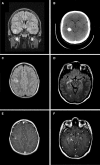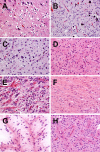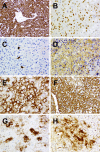Polymorphous low-grade neuroepithelial tumor of the young (PLNTY): an epileptogenic neoplasm with oligodendroglioma-like components, aberrant CD34 expression, and genetic alterations involving the MAP kinase pathway
- PMID: 27812792
- PMCID: PMC5325850
- DOI: 10.1007/s00401-016-1639-9
Polymorphous low-grade neuroepithelial tumor of the young (PLNTY): an epileptogenic neoplasm with oligodendroglioma-like components, aberrant CD34 expression, and genetic alterations involving the MAP kinase pathway
Abstract
Epileptogenic tumors affecting children and young adults are a morphologically diverse collection of neuroepithelial neoplasms that, as a group, exhibit varying levels of glial and/or neuronal differentiation. Recent advances in molecular profiling technology, including comprehensive DNA sequencing and methylation analysis, have enabled the application of more precise and biologically relevant classification schemes to these tumors. In this report, we describe a morphologically and molecularly distinct epileptogenic neoplasm, the polymorphous low-grade neuroepithelial tumor of the young (PLNTY), which likely accounts for a sizable portion of oligodendroglioma-like tumors affecting the pediatric population. Characteristic microscopic findings most notably include infiltrative growth, the invariable presence of oligodendroglioma-like cellular components, and intense immunolabeling for cluster of differentiation 34 (CD34). Moreover, integrative molecular profiling reveals a distinct DNA methylation signature for PLNTYs, along with frequent genetic abnormalities involving either B-Raf proto-oncogene (BRAF) or fibroblast growth factor receptors 2 and 3 (FGFR2, FGFR3). These findings suggest that PLNTY represents a distinct biological entity within the larger spectrum of pediatric, low-grade neuroepithelial tumors.
Keywords: BRAF; Epilepsy; FGFR2; FGFR3; Low-grade neuroepithelial tumor; Oligodendroglioma.
Figures





References
-
- Aronsson DE, Muhr C. Quantification of sensitivity of endothelial cell markers for the astrocytoma and oligodendroglioma tumours. Anticancer Res. 2002;22:343–346. - PubMed
-
- Birner P, Gatterbauer B, Oberhuber G, Schindl M, Rossler K, Prodinger A, Budka H, Hainfellner JA. Expression of hypoxia-inducible factor-1 alpha in oligodendrogliomas: its impact on prognosis and on neoangiogenesis. Cancer. 2001;92:165–171. doi: 10.1002/1097-0142(20010701)92:1<165::AID-CNCR1305>3.0.CO;2-F. - DOI - PubMed
MeSH terms
Substances
Grants and funding
LinkOut - more resources
Full Text Sources
Other Literature Sources
Medical
Molecular Biology Databases
Research Materials
Miscellaneous

